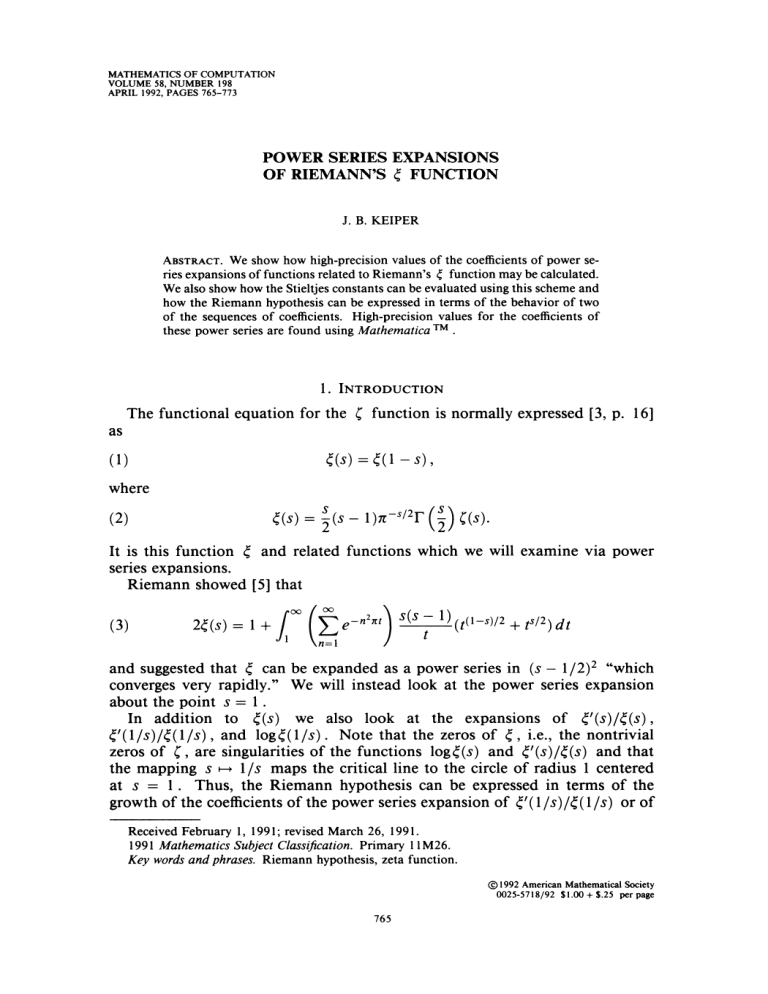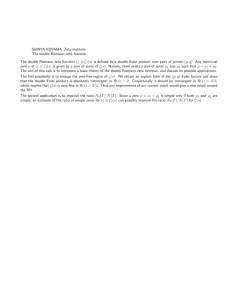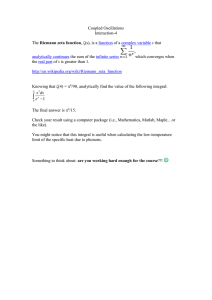
mathematics of computation
volume 58,number 198
april
1992, pages 765-773
POWER SERIES EXPANSIONS
OF RIEMANN'S £ FUNCTION
J. B. KEIPER
Abstract.
We show how high-precision values of the coefficients of power series expansions of functions related to Riemann's í function may be calculated.
We also show how the Stieltjes constants can be evaluated using this scheme and
how the Riemann hypothesis can be expressed in terms of the behavior of two
of the sequences of coefficients. High-precision values for the coefficients of
these power series are found using Mathematica ™ .
1. Introduction
The functional equation for the Ç function is normally expressed [3, p. 16]
as
(1)
His) = til-s),
where
(2)
^) = J(5-i)^/2r(0c(5).
It is this function E, and related functions which we will examine via power
series expansions.
Riemann showed [5] that
(3)
2Zis)
=1+ T (fZe-"2A^-V'-i)/2 +ts'2)
dt
and suggested that t, can be expanded as a power series in is - 1/2)2 "which
converges very rapidly." We will instead look at the power series expansion
about the point s = 1 .
In addition to £(s) we also look at the expansions of <f(s)/¿;(s),
<i;'(l/s)/<!;(l/s) , and log¿;(l/s). Note that the zeros of ¿;, i.e., the nontrivial
zeros of Ç, are singularities of the functions log^(i) and Ç'(s)/Ç(s) and that
the mapping s i-> l/s maps the critical line to the circle of radius 1 centered
at 5 = 1. Thus, the Riemann hypothesis can be expressed in terms of the
growth of the coefficients of the power series expansion of Ç'(l/s)/Ç(l/s) or of
Received February 1, 1991; revised March 26, 1991.
1991 Mathematics Subject Classification. Primary 11M26.
Key words and phrases. Riemann hypothesis, zeta function.
© 1992 American Mathematical Society
0025-5718/92 $1.00+ $.25 per page
765
766
J. B. KEIPER
logeai/s) : the Riemann hypothesis is equivalent to the radius of convergence
being 1.
2. Power series expansion of Ç(s) about
5= 1
To find the power series coefficients of Ç(s), we examine the derivatives of
Ç(s) at s = 1. In particular, if we let
oo
(4)
2<^)= 5>;(s-iy,
7=0
then by induction on (3), we get
(5)
a0 = 1
and
a, = /3,_2 + /3,_i
for j > 1,
where
(6)
/?-i=0,
y90=l + i-log(2v^),
2
and
(7)
ß} = jj^e-^y^^i^t
(logv^y
+ i-iy)dt
for;>l.
3. Power series expansion of Ç'(s)/Ç(s)
We also wish to get the values of ak+l , where
(8)
f^ =E^+-(1-^-
(The reason for the factor of (-l)k
and the subscript of k + 1 will become
apparent below.) To find the values of ok+i, we can multiply the power series expansion of 2Ç'(s) by that of l/(2£(s)). We note that the power series
expansion of l/(2<^(s)) is given by
DC
(9)
l/(2í(í)) = 5]fl„(í-l)",
«=o
where
n
(10)
a0 = 1 and an = -'YZaian-j,
7=1
as can be seen by examining the product of the expansions of 2£,(s) and
l/(2£(s)).
For small values of k this method of computing the coefficients ak+i works
well. However, the cost of computing each coefficient increases linearly with
the index. Because, as we shall see below, there is another method whose cost
per term does not increase at all, we only use this method for small k . There is
also an issue of numerical ill-conditioning in the calculation of the ok+i from
the ßj. However, this ill-conditioning is not nearly so bad as that of Lehmer's
method, which loses nearly 0.85 digits per coefficient [4, equation (12)].
POWERSERIESEXPANSIONSOF RIEMANN'S { FUNCTION
767
We use a different approach for large k . From the well-known product over
all nontrivial zeros of the Ç function [3, p. 20],
«.>-èn(«-i)
(11)
we get
(12)
logfts)
p-l
log2 + ^log
+E1°g(1-
p-l
-*♦^H)-t^im
(13)
Note that at s = 1 we get the identity £
Differentiating (13), we get
TO =E
(14)
fc=i
loB(l -!//>) = 0 since £(1) = 1/2.
1
£
(1-5)
(1-/7)*
k-1
and we see that
(15)
°k Ç(l-/»)*Ç/'
Note that the functional equation for £ applied to ( 13) at s = 1 yields
OO
j
(16)
/t=l
and applied to ( 14) at s = 1 yields
(17)
ax -
zZffkk=\
In general, the functional equation applied to the yth derivative of ( 14) yields
(is)
oj+x= (-irxjz(k'l)ok.
k=l ^
J
'
We can use these identities as consistency checks on the values of ak .
For k large, the sum of the —k powers of the nontrivial zeros of the zeta
function is rapidly convergent. For k small we must get the values of ok from
the values of a.¡.
4. Power series expansions of related
To get the power series expansions for
(19)
Í(1/í)
= £>(!-*)*
k=0
and
(20)
log(2¿(l/S)) = £A,(l-5)fc,
fc=0
functions
768
J. B. KEIPER
we need the following: if
oo
(2i)
/(z) = 5>„(z-iy,
n=0
then
(22)
zZ(m i11
ffà-o+t
n- 1
m=l Ln=
(l-z)*,
which can be seen from the fact that
(23)
(L-iY=
(1~z)" =(i-zr
U V [i-(i-z)]»
(1 zj
Jt=0
and collecting like powers of ( 1-z).
for the coefficients:
Using this, we get the following expressions
(24)
to = ox,
(25)
T*= E(/_;)(-1)^+'
k-l
forfc>l
7= 1
(26)
¿0 = 0,
k
(27)
7= 1
7-1
J
As with ok , further identities can be derived, which can be used for checking
consistency. In particular, substituting ( 18) into the expressions for xk and Xk,
we get
tfc= - E i
(28)
j + k - 2\
k r
7=2
OC
-l^(j
(29)
+ k-\\
7= 1 V
5. Further
7
observations
From (28) we see that
oo
(30)
tm_i = -£
Jm-l)aj-
j=m
(31)
=-E E L~-\
I
j=m
(32)
= -zZ(P-irmP
p
-Ç^î '
/
(33)
m-2
\ rn
-m-2
POWER SERIES EXPANSIONSOF RIEMANN'S { FUNCTION
769
Likewise, from (29), Xk can be expressed in terms of a sum over p, namely
(34)
¿-n
m ^—'
1
p-\
In fact, xm is just the second central difference of mXm :
(35)
xm = (m + l)Xm+x- 2mXm+ (m - l)Aw_i.
From (33) it is clear that the Riemann hypothesis implies that the values of
\xk\ are bounded by
5>l
(36)
0.04619141793224206762862.
Conversely, if the \xk\ are bounded, then by (19) the Riemann hypothesis must
be true. It is also clear that the failure of the Riemann hypothesis (if such is the
case) would be rather difficult to observe in the growth of the numerical values
of the coefficients xk , since k would have to be extremely large before a (large)
p which is off the critical line would yield \p/(p - l)\k large.
Likewise, from (34) it is clear that the Riemann hypothesis implies that Xm>
0 for all positive m . In fact, if we assume the Riemann hypothesis, and further
that the zeros are very evenly distributed, we can show that
(37)
Xn
log m
log(27î)+ 1 - y
2
2
This comes from the fact [3, p. 132] that the number of zeros p in the critical
strip with 0 < Im p < T is
T
(38)
T
T
î
15
10 h
!.
;
!
'Â\àA
im' m\
|! '1000 ï ï : 20d0
-5
3000 J
L
I I
-10
Figure 1
Plot Of m (Xm - (=|2Î _ log(2*)+l-y^
7000
770
J. B. REIFER
and (34). Note that this asymptotic conjecture is much stronger than the Riemann hypothesis. Even the coefficient of the log m (not to mention the constant
term) could be altered by a slight preference of the zeros to cluster at, or avoid,
the points 1/2 + 2itan((2k + l)n/(2m)).
This approximation to Xm agrees
rather well with the observed behavior of these numbers (cf. Figure 1).
6. Stieltjes
constants
The Stieltjes constants are the numbers y„ in the Laurent expansion
«V
^) = 73T + E(-1)'IS(J"1)',
(39)
n=0
In this section we show how the coefficients o¡ can be used efficiently to evaluate
the Stieltjes constants.
Taking the logarithm of both sides of (2), we see that
(40)
log(5-l)C(s)
= log2{(s)-i-ilog7r
2—
2 ■l°8K-log[ir(!)].
Employing equation 6.1.33 (p. 256) of [1] with I + z = s/2, we find that
1-(1
= [log2+ ^iU5'
iog[,r(i)
(41)
0-1
+E^n+(i-*)r.
H=2
Substituting this into (40), we get that
log(j-l)C(j)=log2{(j)
1
1 -y
+ 2 log ti- log 2 + ——
- 1
E C(«)
n2"
B=2
1,
-log7T+^-
(42)
+E C{n)-l
2"
y-\
(I-S)
n=l
OO.
OO/
.N.OO
.
(i-sy.
~Ey
2wL-_iJE(2fcjïï
7=2 J
n=j XJ
/ k=2 V '
Now we know that
lOg(s - l)Ç(S) = 7(5-1)
and that
oo
+
<
log2£(5) = -£7a;(l-5y
7=1
Hence, to get the coefficients of the constant and linear terms to be correct, we
must have that
(43)
3 C(n)-l
1-7
«2"
n=2
and
C(H)-1
(44)
2n
n=2
log 2-
1
POWER SERIES EXPANSIONSOF RIEMANN'S £ FUNCTION
771
Furthermore, since for large x
OO
(45)
i
. \
El/Ii)*""^*-1)-'.
n=j ^
'
we get that (42) simplifies to
OO
(46)
.
log(j-l)C(s) = y(s-l)-E7
<7,+ £(2fc-l)
7=2 J
(1-5)
k=l
By taking the exponential of this series we get that 7o = 7 and
yk
1 (
Ç(k + 1,3/2)
k\~ k + l\ak+x + ~ 2*+>
(47)
fc-i
^O'-l)!
7=1 u
yk_x
7(^-l)!
, C(fc+l-;,3/2)
CT^+i-7+-2^+TZ>'
It should be noted that we could also map s to l/s in (46) and get the
series expansion of log(l/s - l)Ç(l/s) about 5=1.
If we do this, we find
that the behavior of these coefficients is very similar to the behavior of the Xm.
In particular, we empirically find that these coefficients are approximated by
Xm- (0.75 - 0.134/m)/ra . Since the evaluation of these coefficients is much
more ill-conditioned than that of the Xm, and the results are so similar, we do
not pursue this further.
We note here that the values we found for the Stieltjes constants are not
consistent with those presented in Table 2 of [2]. In particular, the number
of correct digits presented there decreases linearly from about ten for 736 to
about three for 750. The value for 755 is correct to ten digits, however. (It
is clear that the error is not in our values, since we can use (39) to evaluate
£(30) with an absolute error of less than 10-26 while the term involving 750
has magnitude greater than 1010.)
7. Practical
considerations
The computations associated with this paper were performed over a period of
several months using Mathematica ™ on a Sun SPARC-station 1. (A few of the
results are presented in the appendix. More complete results are available by email from the author.) With careful coding these computations can probably be
extended by at least an order of magnitude, more on a more powerful computer.
Here we discuss some of the practical considerations in such computations.
A major difficulty is the evaluation of ßj using (7). In fact there are two
things that can be done here to make the computation efficient. First the theta
function Y^x e" nt can De evaluated for any t with a single evaluation of
the exponential function and relatively few multiplications. The sum converges
rapidly and we include only the significant initial terms. The terms cn in the
sum are evaluated as follows:
1. Let ci —e~nt, a = c\, and bi —aci.
2. Let cn+i =cnb„ and b„+i =b„a.
This algorithm is based on the fact that the differences of successive square
integers are the successive odd integers.
J. B. KEIPER
772
The other thing that can be done to make (7) efficient is to use a doubleexponential quadrature routine. In particular, by reparametrizing the integral
with t = 1 +eT and using the trapezoid rule with sufficiently small stepsize (i.e.,
progressively halving the stepsize until the estimated error is sufficiently small),
the error converges to 0 faster than any power of the stepsize. Since we have
(17) and ( 18), we can check for consistency in the values of ak and do not need
to go to great lengths to estimate the error incurred in the quadrature routine.
Another point to be aware of is that, as mentioned in §3, only the first several
hundred values of ak can be efficiently calculated by dividing the series expansion of £'(5) by the series expansion of £(5) ; for larger values of k , ok is best
evaluated by directly summing inverse powers of the zeros of the £ function.
Finally, for very extensive calculations, Xk calculated using (27) suffers from
ill-conditioning. Since Xk can also be calculated using (34), we can combine
these two formulae and express Xk using (34), where only the first several hundred zeros are included, and (27), where the first several hundred zeros are not
included in the a¡. In particular,
(48)
mAm
= £l-(^i_)
-£(-l);(7K„,
¡=1
JI
7=1
where
¡V
°j,N = oJ~YJplJ
= E
i=l
pi3-
i=N+l
This splitting was not used in the calculations presented in the appendix.
Appendix
0
1
2
3
4
5
G
7
8
9
10
20
50
100
150
0
1
2
3
4
5
6
7
8
9
10
20
50
100
200
500
1000
2000
4 000
+1.000000000000000000000000000000000000000000000000000000000000000000000000000000000000
+2 30957083er. 12103381 4 31024 790649529102 19321 27 1520507595253920
7221 297 13564 767245 7997060
+2.334386453422618313488235688581048104526888044078135299348696644526116274679Ü96133916
+ 4 979R384992294867235117177438948835315334
051190311104 49 7297362224907169515900015794
28
+2.5318173031652
70050561210841163734781216247612468051093200452509966062325514970559737
+5 050254 79221917416958523522501318480215504985511594
6521 G106529482787922163094854
32300
+ 1.72098704 1861535577 78015497390409413208675
7701702736404
92732653541994
761232 7570250219
+3.2378414618810
76960348065919673406208942012226904286279830767694
63572375809859074
94 85
+8.315968250027721630708768786514767520775647323890266412483461676055203222011449340850
+1.4 8524 1921491894004
522583848964
37075315909
7364 504236458 74 51720514 704 54227592811777777
+3.06556023276333135102794999684
7607133510104395172773667917752758424
7165585867914
34 523
+ 1.21347796228754351135596625351326168271961297368943G922822958351364232532287469188071
+1 070429069154838313385730657548585059360262503178231537091411311695927258846590593
155
+ 1.24088282362506620893037291526482665236798782180111971835151016271037166227273
i 271696
+ 9.301133713519577941106852678425151215251212111733219503319190171539887089162064C16490
-6.931 4718055994 53094172321214 58176568075500134360255254120660009493393G21969G94715C059
+2.309570896612103361431024
79064952916219321271520507595253920722129713564
76724 5799 7060
+1.6172867611023335192864
24 30960339433870601083141232516998162989669920916015580577058G
+6.92129735181082679304
9 7348872601068994212026393200243617482708163383C2839264945530537
+9.219761987306040964762787240943901806554167349021320120577971421273G5C330664447565730
+1 151085428922351901862212810985727667131913230359599079058195163871909012767247281564
+ 1.3792766671372988290416713700341G6635613896607865118343234
142993649G63991732212866017
+1.60G371596529912129404028725738536629228244204616261630354868022262189016191508610357
+1.8321915964338257908193931774
72185984899809827343160582307322192294
7437856544 54 74 3098
+2.05657336709170461702893874
2134 330171123655311001356019608197727988730111162823206002
+2.279339363193157713693031057368115338071838591273812761961181306973082998101113724070
+ 4.36463843G046607504799730676723601114195612735190971614216281556533840G97163660121700
+8.70621929767480365979039399697231372288809100489981120578374477336128
70S 2489659362130
+ 1.166037753767913299273616983979379269329870235932278763121893659002312G2503G57581723
7
+1.53327862125672383206361275
7853109720910012178584
4 99538589934990609065918305397665939
+1.9638001859844898940936675926629833651284
4152193691632641423273119401230374
7101292110
+2.3260531616864C6457406504694083223815804
498204109294 22268906325081761229530101l763630
+2 675879769130751756905349140785670258231G9O6027478G7O421829608707310228043OG8C8201l18
+ 3.017616905899266567675908190706132690834964073030616134616701738744
134221G81561687322
(0)
(-2)
(-2)
(.4)
(-4)
(-6)
(-6)
(.g)
(-9)
(-10)
(-11)
(.24)
(-71 )
(-161)
(-260)
(.1)
(-2)
(.2)
(-2)
(-2)
(-1)
(.1)
(.1)
(-1)
(-1)
(-1)
(.1)
(.1)
(0)
(0)
(0)
(0)
(0)
(0)
POWER SERIESEXPANSIONSOF RIEMANN'S f FUNCTION
1
2
3
1
5
6
7
8
9
10
20
50
100
200
400
+2 30957089CG12103381431024790C19529162193212715205075952539207221297135C17672157997080
-1.61543172958O46O275710799O379O7730353026796232414499O3188181535O8O1267621966695517O13
-1 111582311521059227626682389115781739611892189865187702731526728912130006262102206830
+ 7.362722126168951832G77130703060151131283159027110029011631235763037817581718916822111
+ 7.15093355762G07735801093913132151322106619331527568
768924307 734997388079534 3345379681
-2.814364169387S62616067156101761237675859726123079019572032672000607516813119833830262
-1.57119111970177211116269258988882906750035353990880912081053306128244
1704 505957969250
+1.268868110950 76071901254 7573198133930329211114577861293367633398192232650203209798305
+ 2.827437155055S87089334396878061404036954927289641233391634424272672199400527476371615
-5.997714847151874594892026289791394537726526162047541113570098071851241127703763514117
+1.482399329662907928147936992117261052747149970744927574926928515355GG51
73366555369365
+1 101679157979498095115971305675098351333604072745152565985494150992931702385953078565
-1 62353377913204 GO137199270264 2202705650063963968
789967681589052949981761719081733920
7
+1 089 7295967 77509865119694 218110721704 667264958 70504 37821739970196065104
721692114 78264
-7 751997439598467511592699186293675133724454
69444 74 772622803612990996333646308224
24 4 85
k
0
1
2
3
1
5
6
7
8
9
10
20
50
100
150
Stieltjes
constants
773
(-2)
(-2)
(.4)
(-5)
(-7)
(.7)
(.9)
(-9)
(-11)
(-12)
(-23)
(-58)
(-115)
(-230)
(-463)
i^.
+5.77215664 90153286060651209008240243104
2159335939923598805767234884867
7267 77664 6709369
-7.281584548367672486058637587490131913773633833133795259900655971110113357151118187809
-9 690363192872318181530386035212529359065806101310719880701365151850755382280111171060
+2 053831120303315866160016512
753381285 715801115110616215181183336913831192112970053571
+2.325370065167300057168170177526068000904169113781850990
758010907121811005315521900302
+7.933238173010627017533318771114448307315394O4584887O7573125626982314821180I7152023797
-2 387693454301996098724
21841908004 27778371515635807863147612530739106755999296387143G9
-5.272895670577510460740975054788582819962534729698953310134042268856827321651111821110
-3.521233538030395096020521650012087117291805337923503566573315073612617
765060653010601
-3.139177111808801817791162379822739062078953859111102975929190181315010331116152837090
+2.05332811909061791683722289237065302959853
771166761303810208
7113530090210 710691751985
+4.663435615115594494005918211335505251131131739256889976707266280985115821300329007011
+1.266236026513227165967252536486575555384835759448901701980956993469732544041271419075
-4.25340157170802696231443851972783582470289310534
7346897162131985636211871067986720565
+8 02885373150681299325661612598989201184246
738789731123900011950061424
09263025740
(-1)
(-2)
(-3)
(-3)
(-3)
(-4)
(-4)
(.1)
(-1)
(-5)
(-1)
(-1)
(2)
(17)
(35)
Bibliography
1. M. Abramowitz and I. Stegun, Handbook of mathematical functions with formulas, graphs,
and mathematical tables, National Bureau of Standards Appl. Math. Ser. no. 55, Washing-
ton, D.C. (Reprinted by Dover Books.)
2. J. Bohman and C.-E. Fröberg, The Stieltjes function—definition and properties, Math. Comp.
51 (1988), 281-289.
3. H. M. Edwards, Riemann's zeta function, Academic Press, New York, 1974.
4. D. H. Lehmer, The sum of like powers of the zeros of the Riemann zeta function, Math.
Comp. 50(1988), 265-273.
5. B. Riemann,
lieber die Anzahl der Primzahlen
unter einer gegebenen
Grosse, Gesammelte
Werke, Teubner, Leipzig, 1892, pp. 145-153. (Reprinted by Dover Books, New York, 1953.)
Also in Edwards [3, p. 299].
Wolfram Research, Inc., P. O. Box 6059, Champaign, Illinois 61826-6059
E-mail address : keiper@wri.com



